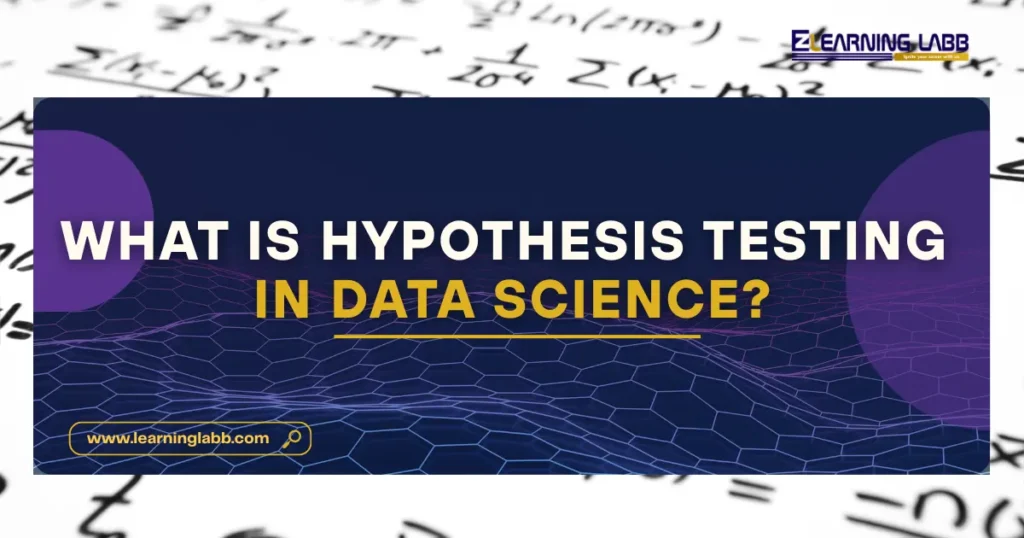Hypothesis Testing in Data Science: If you are like me, pretty sure you’ve ever wondered how data scientists make smart decisions using numbers, statistics, and logic – hypothesis testing in data science is often the secret sauce. But wait, what is hypothesis testing in data science exactly?
What is Hypothesis Testing in Data Science?
If you’ve ever wondered how data scientists make smart decisions using numbers, statistics, and logic, hypothesis testing in data science is often the secret sauce. But wait, what is hypothesis testing in data science exactly?
In simple terms, hypothesis testing is a statistical method used to make decisions or draw conclusions based on data. It helps determine whether there’s enough evidence in a sample of data to support a particular belief (called a hypothesis) about a population.
Here’s an everyday example:
Imagine you’re running an online store and want to know if a new product description improves sales. You test it on 100 visitors and compare the results with the previous version. Hypothesis testing helps you figure out if the difference in results is real or just random noise.
As Nobel laureate Ronald Fisher once said,
“The value of a result is only as good as the test you use to get it.”

What is the Purpose of Hypothesis Testing?
Before jumping into the mechanics, let’s first answer: what is the purpose of hypothesis testing?
In data science, the main aim is to validate assumptions using data. Businesses, researchers, and analysts rely on it to:
- Make data-backed decisions
- Minimise guesswork
- Validate models and features
- Test performance metrics or changes (like in A/B testing)
In short, it gives you a reliable way to say: “Yes, this works” or “No, it doesn’t” backed by evidence.
The 7 Steps in Hypothesis Testing
Now let’s get to the good part: the 7 steps in hypothesis testing. This is your framework-your roadmap.
Remember this: hypothesis testing isn’t just a formula. It’s a process, a way of thinking through data logically.
Here are the 7 steps in hypothesis testing explained simply:
1. State the Hypotheses
You define two competing hypotheses:
- Null hypothesis (H₀): No effect or no difference
- Alternative hypothesis (H₁ or Ha): There is an effect or difference
Example:
H₀: The new product description does not affect sales.
H₁: The new product description increases sales.
2. Set the Significance Level (α)
This is your tolerance for error – commonly set at 0.05 (5%). It means you’re okay with being wrong 5% of the time.
3. Choose the Test Type
Depending on your data type and sample size, you choose a test like:
- Z-test
- T-test
- Chi-square test
- ANOVA
We’ll explore these under types later.
4. Collect the Data
This is where you gather the sample data you need. Real numbers, real observations.
5. Perform the Test
Use statistical formulas or software (like Python, R, Excel) to compute the test statistic and p-value.
6. Compare P-value with α
The p-value tells you the probability your result occurred by chance. If:
- p ≤ α → Reject the null hypothesis
- p > α → Fail to reject the null
7. Draw a Conclusion
Based on the above, make a decision: is the effect real or just noise? Always interpret the result in the context of your problem. Numbers alone don’t tell the full story.
Types of Hypothesis Testing in Data Science
Different situations call for different testing methods. Here are the most common types of hypothesis testing in data science:
1. Z-test
Used when:
- Sample size > 30
- Population variance is known
2. T-test
Great for small sample sizes (<30) where population variance is unknown.
Variants include:
- One-sample T-test
- Two-sample T-test
- Paired T-test
3. Chi-square Test
Perfect for categorical data. Often used in surveys or experiments.
4. ANOVA (Analysis of Variance)
Used when comparing means across three or more groups.
5. F-test
Used to compare variances between two populations.
Each test has its own use-case. The key is matching the right test to your problem.

Read More: The Role of Statistics in Data Science: Key Concepts Explained
Hypothesis Testing Examples and Solutions
Let’s look at some hypothesis testing examples and solutions that you might come across in data science or analytics.
Example 1: E-commerce Conversion
Problem: An e-commerce company wants to check if a new checkout design increases conversions.
- H₀: New design has no effect.
- H₁: New design increases conversions.
Solution: Use a two-sample T-test to compare the average conversion rate between old and new designs.
Example 2: Student Scores
Problem: Is there a significant difference in maths scores between two coaching centres?
- H₀: Both centres produce equal results.
- H₁: One centre performs better.
Solution: Apply a two-sample T-test or ANOVA, depending on group size.
Example 3: Survey on Buying Preferences
Problem: Are buying preferences related to gender?
- H₀: No relationship between gender and buying.
- H₁: There is a relationship.
Solution: Use a Chi-square test for categorical data.
Process of Hypothesis Testing: From Start to End
Let’s now look at the process of hypothesis testing from an end-to-end perspective, tying it all together.
Step-by-step:
- Understand the problem and define your hypothesis
- Choose the right test type based on data
- Set significance level
- Collect relevant and clean data
- Run the test
- Interpret the p-value
- Report results clearly
“Statistical significance is not the same as practical importance,” says David Hand, Professor of Statistics at Imperial College London.
Always combine statistical output with domain knowledge before making decisions.
Common Mistakes to Avoid
While hypothesis testing in data science is a powerful tool, it’s often misused. Watch out for these mistakes:
- Misinterpreting the p-value (It’s NOT the probability H₀ is true)
- Forgetting to check assumptions (normality, sample size)
- Running multiple tests without correction
- Ignoring effect size or confidence intervals
Tips for Applying Hypothesis Testing in Data Science Projects
Here’s how to make hypothesis testing part of your workflow:
- Use it early during EDA (Exploratory Data Analysis)
- Apply in A/B testing for product decisions
- Validate machine learning models
- Back marketing strategies with numbers
Tools to Use:
- Python (scipy.stats, statsmodels)
- R (t.test, chisq.test)
- Excel (TTEST, ZTEST)
- Power BI and Tableau (built-in functions)
On A Final Note…
So, by now you should feel a lot more confident with the concept of hypothesis testing in data science. Whether you’re building dashboards, training ML models, or just digging through Excel sheets, hypothesis testing is your go-to tool to stay objective.
Remember the core idea:
“A hypothesis test isn’t about proving something. It’s about testing if the evidence is strong enough to support a claim.”
From understanding what is hypothesis testing in data science to exploring types, the 7 steps in hypothesis testing, and even solving real hypothesis testing examples and solutions – we’ve covered it all.
Got data? Use hypothesis testing to let it speak for itself.

FAQs
Q1. What is hypothesis testing in data science?
It’s a statistical method to decide whether your assumption about data is valid, using probability and evidence.
Q2. Why is it important in data science?
It removes guesswork and gives you a data-driven way to validate ideas.
Q3. What are the 7 steps in hypothesis testing?
State hypotheses, set significance level, choose test, collect data, perform test, compare p-value, draw conclusion.
Q4. What are the types of hypothesis testing in data science?
Z-test, T-test, Chi-square, ANOVA, and F-test.
Q5. Can I use hypothesis testing for machine learning?
Yes, especially during feature selection, model evaluation, and A/B testing.





